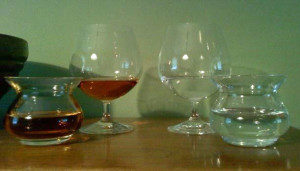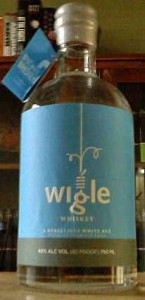By S.D. Peters
When tasting whiskey for my Whiskey Reviewer work, I had been using a snifter. Yet at its best, the snifter is only half a step up from a tumbler or shot glass, and only because its positives just outweigh its noticeable drawbacks. The now well-established Glencairn Glass is one option I have not yet had an opportunity to try, but another choice that I recently investigated is the relatively new NEAT Glass. As my colleague Jake Emen discovered with his Glencairn Glass, trying the NEAT Glass left my snifters on the shelf to gather dust.
NEAT vs. Snifter: Characteristics
The snifter’s biggest disadvantage is its concentration of astringency: inhale too deeply, and it’ll numb your nose the way a too-hot cup of coffee does your tongue. A metallic odor seers into the nasal passages, and compromises the ability to detect subtleties in the nose of a whiskey – or any aroma at all. A lighter touch is required: a series of short sniffs, just above the rim of the snifter, brings out the vanilla, oak, pepper, leather, tobacco, berry, and other scents common to a nicely aged whiskey. Yet a certain astringency remains, complicating the process of finding the elusive muted 5th that distinguishes an average from an above-average, and an above-average from a classic whiskey.
The NEAT Glass boasts an ability to eliminate “nose burn and numbing”. The design aims to that end, being quite non-traditional when it comes to the line of glassware most commonly associated with whiskey. It’s a fine looking little glass, with a nice bottom-weight when cupped in the palm, but is vase-like in appearance – a little like a votive candle holder. An antiquarian might even say, a small spittoon.
Derogatory? Hardly: a glass shaped like a device commonly found in saloons seems an appropriate design for the saloon-goers beverage of choice. I rather like the design.
NEAT vs. Snifter: The Method
The NEAT Glass makers recommend filling the Glass to its widest diameter, which is about half-full, holding it level between the thumb and forefinger, and swirling the contents “several times just prior to nosing.” Placing the nostrils over the center of the rim is the best way to experience the aromas that can be more difficult to find in a snifter. This is what I did, varying the positions to see if I could detect any additional qualities. For comparison, I also filled a regular snifter with an equal amount of whiskey.
I did not add water – which I’d say is “as recommended” (it is), except I never add water anyway, at least not for an initial tasting, and certainly not to any whiskey 101 Proof or less.
Free from astringency, the complexities of whiskey expressions should be easier to detect – and enjoy – when tasting. I tried three types of whiskey in both the NEAT Glass and a snifter for comparison. Two I had previously reviewed, Hancock’s President’s Reserve Bourbon and Wigle White Rye. The third, (rī)1 – pronounced “Rye-1” – is a Straight Kentucky Rye I hadn’t previously tasted.
NEAT vs. Snifter: The Test
I began with the Wigle White Rye, and it was as fine an experience as when tasted from a snifter. Therein the problem: there was no discernable difference between tasting it from a snifter and the NEAT Glass. Wigle White Rye, similar to other white whiskeys of 40% ABV I’ve tried, has a mellow nose. Even in a snifter, the alcohol is not its prominent feature: the essence of its grain is. The NEAT Glass appears to offer little advantage for tasting white whiskeys, but rendering judgment on a glass’s performance on white whiskey alone would be unfair and misguided.
On to the Hancock’s. Here, the difference was pronounced. Out of the snifter, the expected potency of the alcohol stung. After a breather of about 10 minutes, I nosed the bourbon in the NEAT Glass. Smooth: that’s the single best, and simplest, word for the experience. Velvety, ethereal, creamy: choose any other synonym you like, the Glass lives up to its boast of dissipating alcohol. While I didn’t experience greater nuances than when I first tasted Hancock’s President’s Reserve, I didn’t have to pause, return, pause, return, as I did with a snifter. The rewards were immediate, even if I can’t say they were greater.
The (rī)1 experience, which was my maiden voyage with that particular whiskey, was similar to the bourbon. No burn. Immediate aromas, albeit, nothing distinguished from what I could detect in the snifter. I didn’t quite know what to expect from (rī)1, but I soon discovered it’s a somewhat mellow Rye, decent, but without distinguishable complexity. I could do that quickly, because I could get into the Rye and stay there.
NEAT vs. Snifter: Results
The NEAT Glass does have a slight learning curve. Placement of the nostrils is very important: precision is the order of the day. As I found, it’s very easy to detect only the vaguest aroma without experiencing anything more complex if the nose is held a millimeter too high or a hair off from the mouth’s center. And when sipping from the Glass, a very wide sip works best; otherwise, the whiskey escapes over the rim and down the side (of the glass and your mouth). The benefit of a wide sip, however, is a fuller coating of the mouth when the whiskey arrives, allowing it penetrate your taste buds without much work on your part.
As my choice of samples makes apparent, I tested mostly mellow whiskeys. I was curious if the NEAT Glass would reveal anything more complex. It did not, but that’s only to my nose. The potential that, for another nose, the undeniable dissipation of alcohol might yield a richer tasting, is worth noting. And the immediate benefit of noting aroma instead of astringency gives the NEAT Glass an edge, regardless of whether or not the tasting experience is richer.
Whiskey might not look as good in a snifter or the NEAT Glass as it does when it’s in a nice, bottom-heavy double glass, but the best glasses for looking aren’t the best for tasting. For that, the NEAT Glass has distinct advantages over a snifter, and I recommend giving it a try. Even if you are satisfied with your snifter, you might find yourself pleasantly surprised.
 The Whiskey Reviewer A World of Whiskey, Poured Every Weekday
The Whiskey Reviewer A World of Whiskey, Poured Every Weekday


